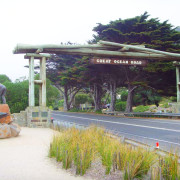What springs to mind when thinking about Australia? Sure, there’s the Great Barrier Reef, Sydney Opera House, kangaroos and endless outback. But inevitably you’ll think of one giant rock – Uluru. We love Uluru but Australia has many more great rock formations that are definitely worth checking out but have never managed to receive the same level of attention. Read on for our pick of some of the quirkiest.
Devils Marbles (Karlu Karlu), Northern Territory
Drive along the Stuart Highway for 4 hours from Alice Springs and you’ll arrive at the Devils Marbles, located 62 miles (100 km) south of Tennant Creek. The Devils Marbles were returned to the traditional owners (Warumungu) in 2008. They call the site Karlu Karlu.
The granite rock was once a single solid layer covering the land but eventually it cracked into rectangular blocks and erosion smoothed the corners, leaving hundreds of boulders dotted around the reserve. Visit at sunrise or sunset to watch the rocks turn pink and red.
Devils Marbles Conservation Reserve (Karlu Karlu)Photo courtesy of Tourism NT
The Pinnacles, Western Australia
In Nambung National Park, near the town of Cervantes is where you’ll find the Pinnacles. A 3 hour drive up the coast from Perth will lead you to these limestone shards jutting out of the sandy dunes of the Coral Coast region.
A variety of theories exist on how the Pinnacles – up to 5 metres in height – came to be, but what is known for certain is that the material they’re made from comes originally from seashells.
The PinnaclesPhoto Copyright Tourism Western Australia
Remarkable Rocks, South Australia
What do you need to create rocks that look this weird? Just wind, rain, the sea, and a spare 500 million years! These battered granite boulders sit by the water in Flinders Chase National Park on Kangaroo Island.
Yet again sunrise and sunset are great times to visit; the strong light brightens the orange lichen covering many of the rocks to creating great photo opportunities. Sadly, when I turned up it was midday and very rainy but the rocks still looked, well, remarkable!
Remarkable RocksPhoto courtesy of South Australian Tourism Commission
Sawn Rocks, New South Wales
The northern section of Mount Kaputar National Park is home to the Sawn Rocks. For the best view of the 40m (130ft) high basalt cliff face, follow the trail to the viewing platform at its base. The phenomenon is (for obvious reasons) known as organ-piping and occurs when molten rock cools slowly and evenly allowing crystals to form and interlock.
Photo courtesy of Mike Newling / Destination NSW
Tessellated Pavement, Tasmania
Fractures in the rock at Eaglehawk Neck have created the appearance of a manmade ‘pavement’. The section further out to sea is submerged much more frequently and surging water has eroded the cracks producing ‘loaves’ of rock.
A little further inland after high tide, the seawater has a chance to dry on the rocks. The crystals formed then erode the rock surface creating what are known as trays or pans. Just over an hour’s drive from Hobart and well worth a look!
Tessellated PavementPhoto courtesy of Tourism Tasmania. All Rights Reserved
Wave Rock, Western Australia
Wave Rock is located in Hyden Wildlife Park and is around 15m (49ft) high and about 110m (360ft) long. It’s the north side of a lone granite hill known as Hyden Rock. Wave Rock and Hyden Rock are part of a much larger rock that has been around for about 2.63billion years, and it is believed concentrated chemical weathering gives the cliff its unique shape today. The closest town is Hyden which is about 3 and a half hours east of Perth by car.
Photo Copyright Tourism Western Australia





